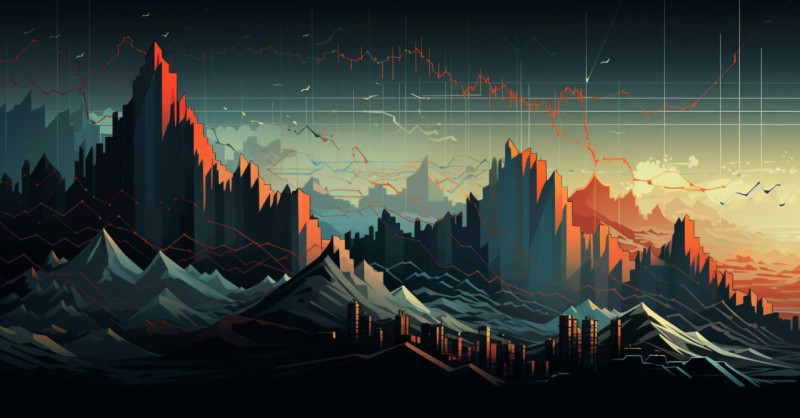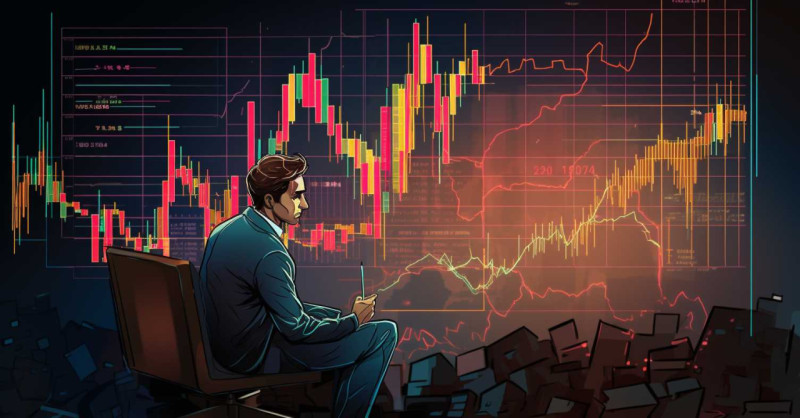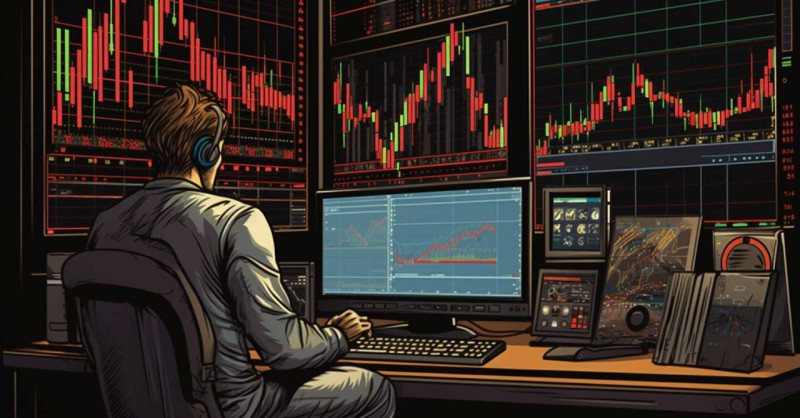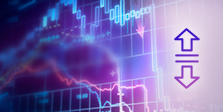
Introduction
In the highly competitive and volatile world of Forex trading, possessing the right tools and strategies to predict price movements can prove instrumental. Among such tools, Wolfe Waves, named after veteran trader Bill Wolfe, stand out due to their unique market pattern recognition ability and forecasting capabilities. This intriguing concept, defined by specific wave structures, allows traders to identify potential price inflection points, thereby optimizing their trading decisions.
To enhance the process of identifying Wolfe Waves, traders often utilize the Wolfe Waves Indicator, a specialized tool designed to assist in the detection of this specific pattern. This indicator not only simplifies the pattern recognition process but also provides traders with clear insights into potential entry and exit points, facilitating more informed and strategic trading decisions.
Recognizing the value and practicality of these tools, particularly in Forex trading, can significantly bolster a trader's capability to navigate the intricate market trends. With the notoriously unpredictable nature of the Forex market, the predictive power of Wolfe Waves coupled with the convenience offered by the Wolfe Waves Indicator can be pivotal resources for traders seeking an edge in this complex market environment. The upcoming sections will delve into a more profound understanding of Wolfe Waves, their identification, and the practical use of the Wolfe Waves Indicator for successful Forex trading.
Understanding Wolfe Waves
Wolfe Waves, an intricate trading strategy, were first conceptualized by the trader Bill Wolfe. Predicated on the observation that specific market patterns could be identified and used to forecast future price movements, this technique has become an invaluable tool for traders worldwide.
At its most fundamental level, a Wolfe Wave consists of five distinct points or 'waves,' which create a 5-wave pattern. These are usually labelled from 1 to 5. The first two waves, waves 1 and 2, form the initial peak and trough. Wave 3, the next peak, should be higher than wave 1, while wave 4, the following trough, should be lower than wave 2. The final wave, wave 5, extends beyond the trendline created by waves 1 and 3, indicating an 'overshoot' of the price. This formation suggests a reversal in price direction, offering traders a hint on potential market entry and exit points.
The mechanics of Wolfe Waves rely heavily on fundamental principles of technical analysis. Key concepts such as support and resistance, equilibrium and disequilibrium, and supply and demand all play significant roles in the formation of these wave patterns. Understanding these principles helps traders predict where the price might go, providing a blueprint for potential market movements.
To illustrate this concept more effectively, consider a real-life example from the Forex market. Let's assume that a currency pair like EUR/USD is exhibiting a Wolfe Wave pattern. After the formation of waves 1, 2, and 3, we see a clear upward trendline. However, the price then falls to form wave 4, breaking this trendline. Subsequently, the price shoots up, forming wave 5 and 'overshooting' the previous trendline. This pattern completion indicates a potential price reversal, suggesting that it might be an opportune moment to sell the currency pair.
Diagrammatic representations are often used to visually illustrate these patterns. These diagrams allow traders to quickly grasp the structure of Wolfe Waves, further facilitating the understanding of this trading strategy. By overlaying a diagram of a perfect Wolfe Wave pattern on a real Forex chart, one can clearly see the correlation between the pattern and actual price movements.
In conclusion, Wolfe Waves, founded on key technical analysis principles, provide a systematic approach to predict potential market trends and reversals. By studying real-life examples and diagrams, traders can effectively understand and apply this tool in their Forex trading practices.

The Formation of Wolfe Waves
Step-by-Step Guide on Identifying a Wolfe Wave
Identifying the Initial Trend
Before the formation of a Wolfe Wave pattern, the price will typically be following a clear upward or downward trend. This trend is the precursor to the development of a Wolfe Wave. Traders need to scrutinize price charts for steady uptrends or downtrends. It's essential to remember that Wolfe Waves can form in both bullish and bearish markets, so identifying the initial trend sets the stage for spotting the pattern.
Recognition of the First Two Waves
Once the initial trend has been identified, traders should look for the formation of the first two waves. The first wave is a clear price peak (in an uptrend) or trough (in a downtrend). Following this, the price will reverse to form a trough (in an uptrend) or peak (in a downtrend), constituting wave 2. These first two waves essentially set the pace for the formation of the Wolfe Wave pattern.
Understanding the Next Peak and Trough (Waves 3 and 4)
The next task involves identifying waves 3 and 4. Wave 3 forms the next peak which, in an uptrend, should be higher than the peak formed by wave 1. In a downtrend, wave 3 should form a trough lower than wave 1's trough. Wave 4 follows as a subsequent trough (in an uptrend) or peak (in a downtrend). Importantly, wave 4's trough should be lower than wave 2's trough in an uptrend, or the peak should be higher in a downtrend.
Identification of the Final Wave
The identification of the fifth and final wave is crucial. Wave 5 should 'overshoot' or break the trendline drawn from waves 1 and 3. In an uptrend, this means the price rises above this trendline, and in a downtrend, it falls below it. This 'overshoot' by wave 5 often signals an impending reversal in price direction.
Confirmation of the Wolfe Wave
The last step in identifying a Wolfe Wave pattern involves confirming its validity. Confirmation often involves looking for a divergence between the price and an oscillator, such as the Relative Strength Index (RSI) or the Moving Average Convergence Divergence (MACD). This divergence indicates that despite the price moving in one direction, the underlying momentum is shifting, which supports the likelihood of a reversal as predicted by the Wolfe Wave pattern. Without this divergence, the identified pattern might not be a valid Wolfe Wave. Traders should remember that the process requires practice and experience for accurate identification and confirmation.
Understanding the Five Points of a Wolfe Wave
Explanation of Wave 1
Wave 1 of a Wolfe Wave pattern is the first visible shift in the current market trend. In an uptrend, wave 1 forms a peak as prices reach a temporary high before reversing. In a downtrend, wave 1 represents a trough, with prices hitting a temporary low before rebounding. This wave is significant as it denotes the potential start of a Wolfe Wave pattern and sets the initial direction for the pattern's development.
Understanding Wave 2
Wave 2 is a corrective wave that follows wave 1. In an uptrend, this wave forms a trough as prices pull back from the peak created by wave 1. In a downtrend, wave 2 forms a peak as prices bounce back from the low set by wave 1. Wave 2 is pivotal in the Wolfe Wave structure, as it establishes the initial reference point for the pattern's progression and sets up the drawing of the baseline (connecting waves 1 and 3).
Unpacking Wave 3
Wave 3 of the Wolfe Wave pattern signifies a continuation of the trend initiated by wave 1. In an uptrend, this wave forms a peak that is higher than the peak of wave 1. Conversely, in a downtrend, wave 3 forms a trough lower than the trough of wave 1. This is a crucial wave, as its relationship to wave 1 helps establish the prevailing trend and provides the second point for drawing the baseline.
Breakdown of Wave 4
Wave 4 is the second corrective wave of the Wolfe Wave pattern. In an uptrend, this wave should form a trough lower than the trough of wave 2. In a downtrend, it should form a peak that is higher than the peak of wave 2. The completion of wave 4 sets the stage for the final wave of the pattern. This wave also forms the channel's upper boundary in a bearish Wolfe Wave and the lower boundary in a bullish Wolfe Wave.
Importance of Wave 5
Wave 5 is the final wave in the Wolfe Wave pattern and plays a critical role. This wave 'overshoots' or breaks through the trendline created by waves 1 and 3. In an uptrend, this means prices should surge above this line, while in a downtrend, prices should drop below it. Wave 5's overshoot typically signals an imminent price reversal. The endpoint of wave 5, coupled with the line connecting the points of waves 1 and 4, helps traders predict where the price reversal is likely to lead, allowing for strategic entry or exit decisions.

Pitfalls and Common Mistakes in Identifying Wolfe Waves
Avoiding False Patterns
One of the common pitfalls when identifying Wolfe Waves is falling for false patterns. Not every similar-looking wave pattern accurately predicts price reversals. Genuine Wolfe Waves adhere to specific criteria regarding the relationships between the waves. For instance, wave 3 must always be beyond the trendline formed by waves 1 and 2, and wave 5 should overshoot the trendline drawn from waves 1 to 3. Traders should be diligent and careful to avoid interpreting every five-wave pattern as a Wolfe Wave. Understanding and applying the specific rules can help distinguish genuine Wolfe Waves from false ones.
Dealing with Ambiguous Waves
Sometimes, wave formations can be unclear or ambiguous, making it difficult to definitively identify a Wolfe Wave pattern. Ambiguity often arises from market noise or when the price action does not neatly align with the idealized Wolfe Wave structure. In such scenarios, it's recommended to use additional technical analysis tools, such as oscillators, to support the interpretation or wait for more definitive signs of the pattern forming before making a trading decision.
Avoiding Confirmation Bias
Confirmation bias, a tendency to interpret information in a way that confirms one's preconceptions, can be a major obstacle in correctly identifying Wolfe Waves. For instance, a trader might overlook key wave details that contradict a Wolfe Wave pattern simply because they expect to see the pattern. To avoid this bias, traders should approach each analysis with an open mind, carefully examining the price action and verifying it against the defined characteristics of a Wolfe Wave.
Understanding the Limitations
While Wolfe Waves can be a powerful tool in predicting price reversals, they are not infallible. Like any trading strategy, Wolfe Waves have their limitations and should not be used in isolation. They can occasionally provide false signals, and their predictive accuracy may vary depending on the market context and timeframe. Traders should always use Wolfe Waves in conjunction with other technical analysis tools and indicators for more robust and reliable predictions. Understanding these limitations can help set realistic expectations and develop a balanced trading strategy.
Wolfe Waves and Market Predictions
The Predictive Power of Wolfe Waves in Anticipating Price Action
Definition of Wolfe Waves
A Wolfe Wave is a natural pattern found in every market. It's made up of five waves, with the first two waves defining a down (in an uptrend) or an up (in a downtrend) channel, the third wave breaking the channel, and the fifth wave extending beyond the trendline formed by waves 1 and 3. The unique structure of the Wolfe Wave pattern and its capacity to predict price reversals make it a highly valued tool in technical analysis.
The Price Reversal Signal
One of the most notable characteristics of Wolfe Waves is their ability to predict price reversals. As a price moves in the direction of the trend and forms the five Wolfe Wave points, the final wave, or wave 5, typically 'overshoots' the trendline drawn from waves 1 to 3. This overshoot signals that the prevailing trend may be running out of steam, and a price reversal could be imminent. When this occurs, traders typically anticipate a reversal to at least the trendline formed by waves 1 and 4. Understanding the significance of this overshooting fifth wave is crucial for successfully harnessing the predictive power of Wolfe Waves.
Limitations and Considerations
While Wolfe Waves can provide a powerful way to anticipate future price action, it's important to recognize their limitations. Like any other form of technical analysis, Wolfe Waves are not always accurate and can sometimes lead to false signals. For instance, what initially appears to be a Wolfe Wave pattern might not result in the anticipated price reversal, particularly in volatile markets. It's also important to note that Wolfe Waves are more about probabilities than certainties; they increase the chances of successful predictions but don't guarantee them. Therefore, it's essential to use risk management techniques and corroborate Wolfe Wave signals with other technical analysis tools to make the most informed trading decisions.

Predicting Both Price and Time of Significant Market Moves
Determining the timing of significant market movements is as crucial as predicting the direction of the price change, and this is where the structure of Wolfe Waves proves to be particularly valuable. The unique 5-wave pattern inherent in Wolfe Waves serves as a roadmap for traders, not only indicating the potential price reversal but also offering clues about the timing of these movements. A key aspect of this timing prediction revolves around the concept of the equilibrium price.
The equilibrium price, often referred to as the 'sweet spot,' is the price point at which supply and demand are perfectly balanced. In the context of Wolfe Waves, this sweet spot is predicted to be the price level that the market will reach after the completion of the fifth wave. This price is typically determined by drawing a line from the point of wave 1 through the point of wave 4. The point where this line intersects with the trendline drawn from waves 1 and 3 gives us the estimated price target or the 'sweet spot.'
Once a trader has these forecasts at their disposal, they can effectively incorporate them into their trading strategy. For example, the equilibrium price can serve as a target for setting take-profit orders, while stop-loss orders can be placed slightly above (in a downtrend) or below (in an uptrend) the trendline formed by waves 1 and 3 to protect against potential false breakouts. Using these projections and practical measures, traders can enhance their decision-making process, manage risk more effectively, and maximize their potential for profitable trades.
Case Studies of Successful Market Predictions Using Wolfe Waves
The predictive power of Wolfe Waves is evident when looking at both historical and recent market data. For instance, by examining the historical market performance of assets like Apple's stock, the EUR/USD currency pair, or even commodities like gold, we can find numerous instances where Wolfe Waves successfully anticipated major price movements. These historical examples underline the pattern's effectiveness under a range of market conditions and provide concrete evidence of its value in predicting market trends.
Moving to more recent cases, Wolfe Waves continue to show their relevance and value in the ever-evolving market environment. Regardless of the asset class – be it stocks, forex, or commodities – traders continue to utilize Wolfe Waves effectively to anticipate price action and strategize their trades. These recent examples underscore the pattern's enduring reliability and its adaptability to the shifts and nuances of contemporary markets.
Finally, every case study of Wolfe Waves offers invaluable lessons for traders. Whether it's about avoiding common pitfalls, managing risk effectively, or leveraging the predictive potential of the pattern, these insights can significantly improve a trader's usage of Wolfe Waves. By carefully examining and learning from each case, traders can enhance their understanding of Wolfe Waves, refining their ability to anticipate market movements and thereby informing their trading decisions.

Introduction to the Wolfe Waves Indicator
A Comprehensive Overview of the Wolfe Waves Indicator
The Wolfe Waves Indicator, named after Bill Wolfe, who first observed and defined Wolfe Waves in the financial markets, is a powerful technical analysis tool designed to identify and illustrate the Wolfe Wave patterns in price charts. Rooted in the underlying principles of market equilibrium and supply and demand, the Wolfe Waves Indicator simplifies the process of spotting these patterns, which can often be laborious and time-consuming, thereby providing a significant advantage for traders.
In essence, the Wolfe Waves Indicator works by automatically pinpointing the five-wave structure characteristic of Wolfe Wave patterns in real-time. These five waves, labeled from 1 to 5, correspond to a sequence of peaks and troughs in the price chart, with the fifth wave typically indicating a price reversal. The indicator plots these points on the chart, providing traders with a clear visual representation of potential Wolfe Wave formations. Armed with this information, traders can then leverage the predictive power of Wolfe Waves to inform their trading decisions and strategies.
What sets the Wolfe Waves Indicator apart from other trading tools is its specialized focus on Wolfe Wave patterns. This makes it a uniquely valuable resource in any trader's technical analysis toolkit. By automating the detection process, the Wolfe Waves Indicator enhances the speed and efficiency with which traders can identify these patterns, saving them valuable time and effort. Additionally, some versions of the indicator offer features such as alerts when a Wolfe Wave pattern is detected or predictive lines showing the expected price trajectory following the completion of a Wolfe Wave. These unique features and capabilities highlight the utility of the Wolfe Waves Indicator and underscore its relevance in contemporary trading environments.

Breaking Down the Components of the Wolfe Waves Indicator
The Wolfe Waves Indicator comprises several integral components, each of which plays a crucial role in the overall functioning and utility of the tool.
Firstly, at the heart of the Wolfe Waves Indicator is the five-point structure, which corresponds to the distinctive pattern of Wolfe Waves. This structure consists of five points, labeled as 1, 2, 3, 4, and 5, which represent a series of peaks and troughs in the price action. The points are plotted in such a way as to form a clear, identifiable pattern, which traders can use to anticipate possible price reversals and formulate their trading strategies.
The second critical component of the Wolfe Waves Indicator is the equilibrium price projection, often referred to as the 'sweet spot'. This is the price point where the Wolfe Waves Indicator predicts the price will move once the fifth wave is completed. The equilibrium price is an important aspect of Wolfe Waves trading strategy because it offers a potential target for where the price may head following the formation of a Wolfe Wave, thereby providing traders with a concrete goal for their trades.
Finally, certain versions of the Wolfe Waves Indicator may offer additional features designed to enhance its utility for traders. These can include real-time alerts that notify traders when a potential Wolfe Wave pattern has been detected, providing them with immediate knowledge of potential trading opportunities. Some versions might also offer predictive price targets that go beyond the equilibrium price, providing traders with further insights into possible future price movements. These additional features vary depending on the specific version of the Wolfe Waves Indicator but can significantly enhance its utility for traders in their technical analysis.
Benefits of the Wolfe Waves Indicator for Traders
The Wolfe Waves Indicator offers a multitude of benefits for traders navigating the complexities of financial markets.
First and foremost, the indicator greatly simplifies the process of identifying Wolfe Wave patterns. Traditionally, traders would have to manually scan price charts, seeking out the distinctive five-wave structure of a Wolfe Wave. This can be a time-consuming and laborious process. However, with the Wolfe Waves Indicator, this task is automated, enabling traders to spot potential Wolfe Waves quickly and efficiently, saving them valuable time and effort.
Another significant benefit of the Wolfe Waves Indicator lies in its ability to enhance the precision and accuracy of a trader's technical analysis. Identifying Wolfe Waves manually can be challenging due to the subjective nature of pattern recognition. However, by utilizing a systematic approach, the Wolfe Waves Indicator minimizes room for human error and interpretation, providing more precise and objective identification of Wolfe Wave patterns.
Lastly, the Wolfe Waves Indicator can be a powerful component of a comprehensive trading strategy. While it is effective on its own, combining it with other technical analysis tools and indicators can provide traders with a more nuanced understanding of market conditions. For instance, traders might use the Wolfe Waves Indicator in conjunction with oscillators or momentum indicators to confirm the validity of a detected Wolfe Wave. By providing real-time identification of Wolfe Waves and potential price targets, the indicator empowers traders to make more informed and confident trading decisions.

How to Use the Wolfe Waves Indicator
Using the Wolfe Waves Indicator effectively involves several key steps, starting with its setup on a trading platform. The setup process usually involves downloading and installing the indicator, which can be done directly from the platform's built-in library of indicators or through a trusted third-party source. Once installed, traders can adjust the settings of the Wolfe Waves Indicator to suit their preferences. For instance, some traders might prefer a different color scheme for better visibility or may want to set up real-time alerts for immediate notification of potential Wolfe Wave formations.
Understanding how to interpret signals from the Wolfe Waves Indicator is crucial for its successful use. Traders should be familiar with the five-wave structure of Wolfe Waves and know how to identify it on their charts. Typically, the indicator plots the five points of a Wolfe Wave, marking the peaks and troughs that form the pattern. When the fifth point, or wave, overshoots the trendline created by waves 1 and 3, it signals a potential price reversal. The projected equilibrium price, or the 'sweet spot', provides a target for where the price might move following the completion of the Wolfe Wave.
To truly grasp the utility of the Wolfe Waves Indicator, it can be beneficial to study real-life trading examples. For instance, a trader may notice a potential Wolfe Wave forming on a forex pair's chart, with the price overshooting the trendline at wave 5. After confirming the pattern with other technical analysis tools, the trader might enter a position at the point of the price reversal, setting their take-profit level at the indicator's projected equilibrium price and their stop-loss level just beyond the fifth wave. This example trade showcases the potential of the Wolfe Waves Indicator in helping traders anticipate price movements and make informed trading decisions.

Conclusion
In conclusion, Wolfe Waves and the Wolfe Waves Indicator provide traders with a powerful toolset for analyzing price movements and predicting potential reversals in the Forex market. By understanding the unique five-wave structure of Wolfe Waves and utilizing the automated detection capabilities of the Wolfe Waves Indicator, traders can streamline their technical analysis and enhance their trading strategies.
Throughout this article, we have explored the concept of Wolfe Waves, delved into the components and functions of the Wolfe Waves Indicator, and discussed the benefits of incorporating these tools into Forex trading. We have seen how the indicator simplifies the identification of Wolfe Wave patterns, improves precision in technical analysis, and offers real-time signals and potential price targets.
As Forex traders, it is essential to embrace innovative approaches and tools that can help us gain an edge in the market. Wolfe Waves and the Wolfe Waves Indicator provide just that. They offer a systematic and reliable framework for identifying potential price reversals and making more informed trading decisions.
So, we encourage you to explore and learn more about Wolfe Waves and the Wolfe Waves Indicator. Familiarize yourself with their patterns, study historical data and case studies, and experiment with incorporating them into your trading strategy. By doing so, you can harness the power of Wolfe Waves and the Wolfe Waves Indicator to potentially improve your trading performance and increase your chances of success in the dynamic world of Forex trading.
















